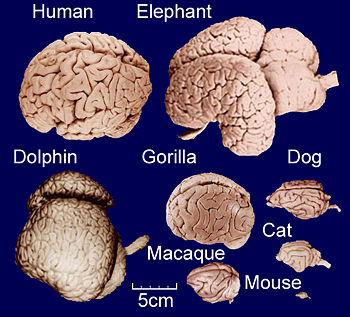Brain size: Difference between revisions
Jump to navigation
Jump to search


imported>Daniel Mietchen (slight expansion) |
imported>Daniel Mietchen (+image) |
||
| Line 1: | Line 1: | ||
{{subpages}} | {{subpages}} | ||
{{Image|ComparitiveBrainSize.jpg|right|350px|Comparative anatomy of brains from various vertebrate species, highlighting the gradual differences in brain size and [[gyrification]].}} | |||
Since the size of the [[brain]] has changed considerably during [[hominid evolution]], '''brain size''' is a central term in many discussions related to [[cognitive evolution]], [[intelligence (biology)|intelligence]] and a number of [[brain disorder]]s, especially [[microcephaly]]. To compare different brains, several indicators of brain size have been used. These include ''absolute brain size'', ''relative brain size'' (normalized by body size or weight), and the [[encephalization coefficient]]. | Since the size of the [[brain]] has changed considerably during [[hominid evolution]], '''brain size''' is a central term in many discussions related to [[cognitive evolution]], [[intelligence (biology)|intelligence]] and a number of [[brain disorder]]s, especially [[microcephaly]]. To compare different brains, several indicators of brain size have been used. These include ''absolute brain size'', ''relative brain size'' (normalized by body size or weight), and the [[encephalization coefficient]]. | ||
Revision as of 22:07, 3 January 2009

(CC) Photo: University of Wisconsin and Michigan State Comparative Mammalian Brain Collections and National Museum of Health and Medicine (see http://www.brainmuseum.org/)
Comparative anatomy of brains from various vertebrate species, highlighting the gradual differences in brain size and gyrification.
Comparative anatomy of brains from various vertebrate species, highlighting the gradual differences in brain size and gyrification.
Since the size of the brain has changed considerably during hominid evolution, brain size is a central term in many discussions related to cognitive evolution, intelligence and a number of brain disorders, especially microcephaly. To compare different brains, several indicators of brain size have been used. These include absolute brain size, relative brain size (normalized by body size or weight), and the encephalization coefficient.